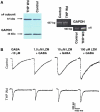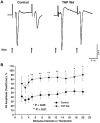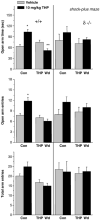Neurosteroid regulation of GABA(A) receptors: Focus on the alpha4 and delta subunits
- PMID: 17512983
- PMCID: PMC2657726
- DOI: 10.1016/j.pharmthera.2007.03.008
Neurosteroid regulation of GABA(A) receptors: Focus on the alpha4 and delta subunits
Abstract
Neurosteroids, such as the progesterone metabolite 3alpha-OH-5alpha[beta]-pregnan-20-one (THP or [allo]pregnanolone), function as potent positive modulators of the GABA(A) receptor (GABAR) when acutely administered. However, fluctuations in the circulating levels of this steroid at puberty, across endogenous ovarian cycles, during pregnancy or following chronic stress produce periods of prolonged exposure and withdrawal, where changes in GABAR subunit composition may occur as compensatory responses to sustained levels of inhibition. A number of laboratories have demonstrated that both chronic administration of THP as well as its withdrawal transiently increase expression of the alpha4 subunit of the GABAR in several areas of the central nervous system (CNS) as well as in in vitro neuronal systems. Receptors containing this subunit are insensitive to benzodiazepine (BDZ) modulation and display faster deactivation kinetics, which studies suggest underlie hyperexcitability states. Similar increases in alpha4 expression are triggered by withdrawal from other GABA-modulatory compounds, such as ethanol and BDZ, suggesting a common mechanism. Other studies have reported puberty or estrous cycle-associated increases in delta-GABAR, the most sensitive target of these steroids which underlies a tonic inhibitory current. In the studies reported here, the effect of steroids on inhibition, which influence anxiety state and seizure susceptibility, depend not only on the subunit composition of the receptor but also on the direction of Cl(-) current generated by these target receptors. The effect of neurosteroids on GABAR function thus results in behavioral outcomes relevant for pubertal mood swings, premenstrual dysphoric disorder and catamenial epilepsy, which are due to fluctuations in endogenous steroids.
Figures






Similar articles
-
Steroid withdrawal in the mouse results in anxiogenic effects of 3alpha,5beta-THP: a possible model of premenstrual dysphoric disorder.Psychopharmacology (Berl). 2006 Jun;186(3):323-33. doi: 10.1007/s00213-005-0168-3. Epub 2005 Sep 29. Psychopharmacology (Berl). 2006. PMID: 16193334 Free PMC article.
-
Puberty, steroids and GABA(A) receptor plasticity.Psychoneuroendocrinology. 2009 Dec;34 Suppl 1:S91-S103. doi: 10.1016/j.psyneuen.2009.05.011. Psychoneuroendocrinology. 2009. PMID: 19523771 Free PMC article.
-
Neurosteroid effects on GABAergic synaptic plasticity in hippocampus.J Neurophysiol. 2003 Apr;89(4):1929-40. doi: 10.1152/jn.00780.2002. Epub 2003 Jan 2. J Neurophysiol. 2003. PMID: 12612040 Free PMC article.
-
The influence of stress at puberty on mood and learning: role of the α4βδ GABAA receptor.Neuroscience. 2013 Sep 26;249:192-213. doi: 10.1016/j.neuroscience.2012.09.065. Epub 2012 Oct 16. Neuroscience. 2013. PMID: 23079628 Free PMC article. Review.
-
α4βδ GABAA receptors and tonic inhibitory current during adolescence: effects on mood and synaptic plasticity.Front Neural Circuits. 2013 Sep 3;7:135. doi: 10.3389/fncir.2013.00135. eCollection 2013. Front Neural Circuits. 2013. PMID: 24027497 Free PMC article. Review.
Cited by
-
Neurosteroid Deficiency Associated With Epilepsy.Epilepsy Curr. 2016 Mar-Apr;16(2):108-9. doi: 10.5698/1535-7511-16.2.108. Epilepsy Curr. 2016. PMID: 27073345 Free PMC article. No abstract available.
-
Increased GABA(A) receptor ε-subunit expression on ventral respiratory column neurons protects breathing during pregnancy.PLoS One. 2012;7(1):e30608. doi: 10.1371/journal.pone.0030608. Epub 2012 Jan 31. PLoS One. 2012. PMID: 22303446 Free PMC article.
-
Effects of neurosteroid actions at N-methyl-D-aspartate and GABA A receptors in the midbrain ventral tegmental area for anxiety-like and mating behavior of female rats.Psychopharmacology (Berl). 2011 Jan;213(1):93-103. doi: 10.1007/s00213-010-2016-3. Epub 2010 Sep 28. Psychopharmacology (Berl). 2011. PMID: 20878318 Free PMC article.
-
Top 100 Cited Papers on Premenstrual Syndrome/Premenstrual Dysphoric Disorder: A Bibliometric Study.Front Psychiatry. 2022 Jul 14;13:936009. doi: 10.3389/fpsyt.2022.936009. eCollection 2022. Front Psychiatry. 2022. PMID: 35911247 Free PMC article. Review.
-
Postpartum State, but Not Maternal Caregiving or Level of Anxiety, Increases Medial Prefrontal Cortex GAD65 and vGAT in Female Rats.Front Glob Womens Health. 2022 Feb 8;2:746518. doi: 10.3389/fgwh.2021.746518. eCollection 2021. Front Glob Womens Health. 2022. PMID: 35211693 Free PMC article.
References
-
- Andreen L, Sundstrom-Poromaa I, Bixo M, Andersson A, Nyberg S, Backstrom T. Relationship between allopregnanolone and negative mood in postmenopausal women taking sequential hormone replacement therapy with vaginal progesterone. Psychoneuroendocrinology. 2004;30:212–224. - PubMed
-
- Angst J, Sellaro R, Merikangas KR, Endicott J. The epidemiology of premenstrual psychological symptoms. Acta Psychiatr Scand. 2001;104:110–116. - PubMed
-
- Backstrom T. Epileptic seizures in women related to plasma estrogen and progesterone during the menstrual cycle. Acta Neurol Scand. 1976;54:321–347. - PubMed
Publication types
MeSH terms
Substances
Grants and funding
LinkOut - more resources
Full Text Sources

